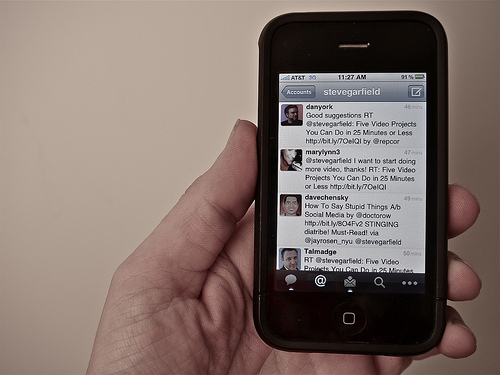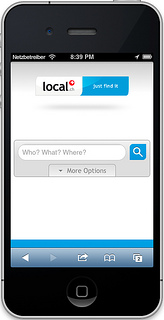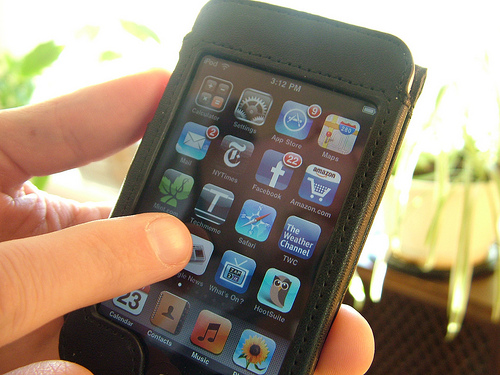Does your business need a mobile presence? It’s one of the most commonly asked questions from business owners, and the answer is surprisingly simple. A recent report from marketing firm, In-Stat, found that 65 percent of Americans will own a smartphone by 2015, meaning the mobile market will consist of more than 200 million potential customers. That’s an average of four million per state. So what do you need to consider to create a mobile site that people will notice?
Is Twitter Enough?
Image via Flickr stevegarfield
One of the quickest ways to get a mobile presence is through the powerhouse social media site, Twitter. This micro-blogging site allows members from across the world to communicate in short 140 character messages. It had over 500 million users in 2012. Even more impressive, it handles over 1.6 billion search queries per day — some of which could be customers looking for you.
Marketing through Twitter is relatively straightforward. However, to be successful, it requires consistent interaction and a thoughtful approach (particularly because of the limited characters). Generic sales messages won’t win followers, but offering quick promotions and highlighting new ranges is an excellent way to generate new sales. For example, a local coffee shop could tweet a special meal deal, or offer a free coffee to the next person who comes in and mentions Twitter. If you could do something similar, Twitter is likely to be highly successful for you.
With twitter, it takes more than just an update a day. Someone needs to monitor your business’ Twitter account so that you are responding to clients, and promoting your business by commenting on other twitter posts. You can’t expect people to watch your twitter account for updates, if you don’t create traffic and respond to comments.
Create a Facebook Fan Page
Like Twitter, Facebook is a leading social media site where businesses can promote themselves through interest groups, and promotional pages. This integrated marketing technique allows a hands-on approach for businesses to communicate regularly with Facebook users. Users can find any information they need about your company through your Facebook fan page, and check-up on daily, or monthly deals. Again, like twitter, you need to be consistent with your Facebook monitoring so that users and potential clients feel like they’re important to your company. As an example, you can see the Facebook fan page for this site here.
Sign-up for LinkedIn
Because LinkedIn’s focus is on the business world and so their profiles are for professionals, creating a company LinkedIn account is incredibly beneficial to your company. You can communicate with potential clients, potential employees, and other businesses as a way of creating connections. The more social media sites your company uses, the more users you will be able to reach.
Optimize Your Website
Image via Flickr Vasile23
It’s time to take a look at your website traffic. How much comes from devices such as tablets, computers, and mobile phones? These visits are often from people in your local area, looking for a business like yours. If your website is easy to view, and informative, then you are likely to generate leads and attract people to visit you. Clunky, slow-loading, or badly formatted sites will have potential customers hitting the ‘back’ button. If you want to attract more attention to your websites, then a drop domain might be a tactical option. When a particular business joins hands with a software company (for example, Domain Hunter Gatherer) to register for a drop domain and build the website on that, they may attract backlinks that can help their SEO efforts.
Also, try loading your website on a few platforms and see how it performs. If it’s slow, clunky, or difficult to use, it’s worth creating a simple mobile site that offers up vital information. Some key elements to a proper mobile site are clear tabs that open different pages of important information. Your pages should not involve a lot of scrolling up and down, or to the left or right. Text on the pages should be large and readable.
Does Your Business Need An App?
Image via Flickr Ilamont.com
Whether an app would be worthwhile for your business, is a major factor to consider. One of the strategies to increase your chances of getting more traction is to start a podcast. Launching a podcast isn’t an easy business, so if you’re having trouble wrapping your brain around it, hire a firm like Lower Street to help you out. Apps are hugely popular across mobile platforms, and it’s becoming a lot more common for a business to have an app. The benefits are clear — once a customer has downloaded your app, you have the ability to send them sale or promotion notifications right to their phone. They’ll see your logo every time they use their phone. They are unbeatable in terms of promotion and lead generation.
The downside? An app is the most expensive way to get a mobile presence, and you will likely need to work with a developer or programmer. They can also take some time to design. If you’ve got a well-designed, intuitive site with clear call-to-actions, you might decide an app isn’t worth the extra cost.
Implement a QR Code
A “quick-response” code is a great way to generate traffic to your site, and spark curiosity in your clients. There are several websites that help you create a QR code. After you create one, you’ll have to decide where you’re going to put this code so that it generates a lot of traffic. If you already have print advertisement space, attaching it to the ad is perfect.
If you have a physical office in a place where a lot of people pass by, placing the QR code in the window with a message attached to it, is another great idea. If users scan the QR code, it is good practice to attach some kind of deal or discount to reward them.
Set up a Text Messaging Campaign
One of the simplest ways to integrate into the mobile online market is to use a service like Tatango to set up a text messaging marketing campaign. If done right, this can be a quick and direct marketing strategy that targets your clients individually. However, the downside to text messaging campaigns is they can seem intrusive and annoying to some people. This could do more harm than good depending on what kinds of texts you send, how often you send them, and if they are of importance. Many text messaging for small businesses campaigns usually try to stick to only texting out deals to clients, and making sure they don’t sound like scams.
Once you’ve considered these factors, you should decide which suits your business most. Twitter and Facebook are free and effective but time-consuming, conversely an app has a higher initial cost but requires very little work afterwards. QR codes can engage the consumer by having them actively seek more information from your business, whereas text marketing can either be very effective if it’s rewarding and gives value, however can be a huge turn off if it’s intrusive, annoying and spammy. Creating an easy to use, fast loading mobile site can be vital, maneuvering around large, small texted, chunky, slow loading sites for a lot of heavily mobile customers means they’re likely to move on to the next nearby competitor that actually has a proper mobile site.
However you do it, in this ever increasingly tech savvy mobile culture, we inhabit the chances of your business succeeding is only enhanced with the (correct) uses of these mobile marketing platforms. So, try implementing a few of these ideas, to create a powerful mobile presence to make potential customers see your company as engaged, contemporary and customer-oriented.




